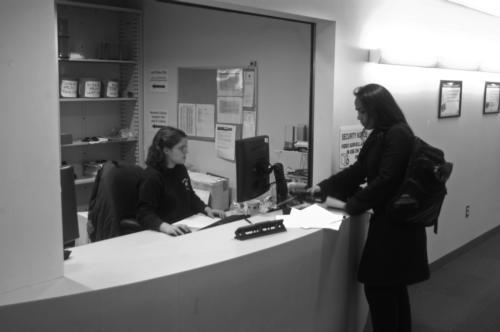
Reading the Signals
In the cyber-age, the furious scribble of pens scratching paper that once filled lecture halls has been replaced by the clacking of laptop keys. Upon closer inspection, this is probably because half of the class is “G-chatting” the other half.
A decade ago, we’d have to be tripping over Ethernet cables in class to achieve such levels of distraction. Now, with Harvard boasting a nearly “wireless campus,” we can discreetly Facebook-stalk even in Expos. But why is it that so often, midway through crafting a comment on some embarrassing photo, the connection gives out?
Even though FAS Information Technology reports a continuous effort to fix wireless problems on campus, Harvard students still gripe. The 2006-2007 Annual Undergraduate Computer Survey, based on 2951 responses, shows a noticeable difference in satisfaction between the River Houses and the Quad (for once Quadlings win out), while freshmen reported a zero percent dissatisfaction rate.
Those in Mass. Hall are better connected than most—43 percent report they are very satisfied, 43 percent are satisfied, and 14 percent are neutral with their wireless connections.
In contrast, the River Houses seem to still be awaiting a flood of signal. Adams House had by far the worst wireless situation, with a reported 36 percent dissatisfied and 16 percent very dissatisfied, landing a majority of the residents in the unhappy column. Clavery residents even admit to trying to pick up non-Harvard network signals to increase wireless capabilities.
Joshua A. Kroll ’09, president of the Harvard Computer Society (HCS), says he uses a desktop computer most of the time to avoid wireless woes. “I know that my roommates who use laptops as their primary computers will sometimes plug in if they’re getting really frustrated with the wireless,” the Adams resident says. But he also notes, “it’s hard because none of the common rooms in most of the Houses have data jacks.”
“I had to wire a very long piece of Ethernet wire under my roommate’s rug to the common room,” he adds.
Dunster comes in second worst in the survey, with a little under half of respondents dissatisfied. Kroll says there are theories within the HCS on what could be causing the bad signal and slow speed in the River Houses. “Basically, the wires in the wall, even though they can support higher speeds, are all tuned to a lower speed, we think, to avoid certain kinds of problems. We’re not completely sure why, but we know that this happens.”
Noah Selsby ’95, client technology advisor for FAS IT, blames the wireless “problem areas” on areas of “extreme traffic” rather than poor design. But in Kroll’s opinion, blame for this traffic should primarily be placed on Harvard, which apparently doesn’t own enough network addresses for so many students at a given time. “My suggestion is that Harvard try to buy some from MIT,” Kroll says.
Kroll also maintains that the antiquity and spatial design of the older Houses could be causing weak wireless access by the Charles. “The River Houses have very peculiarly shaped halls and rooms,” he says, explaining that this limits where Internet cables can be inserted into the outdated floor plans. Along these lines, Kroll attributes the general wireless satisfaction in the Quad—with Pforzheimer House topping at 73 percent satisfied and only 14 percent dissatisfied—to the fact that its buildings are more “regularly shaped,” and can thus be covered with fewer access points.
Despite the fact that dissatisfaction reports show a stark contrast between the River Houses and the Quad, Selsby claims that the reports of wireless problems to the IT help desk show no “actual difference.”
“It may be that they’re not calling us, which is part of the problem,” he says, declining to comment on FAS IT’s budget plan for fixing these wireless problems and beginning renovations.
Furthermore, while FAS may not be slowing your studious Internet endeavors, Selsby notes that Harvard is purposely tempering Internet related activities that “don’t have a direct academic purpose.”
“There are certain types of applications which we specifically limit, like file-sharing apps,” he says. “If you don’t control that on our network, it will literally eat up the entire network. [...] Yes, those apps will run slowly, and that is by design.”
In addition to trouble connecting in the first place, some students also cite problems of security on the Harvard network. “I have a friend in Kirkland who got identity-thefted on the wireless network,” says Justin W. White ’10, claiming that the friend lost $900.
To avoid identity theft, Selsby urges students to use wired connections when possible, saying that this will also increase Internet speed. But he adds the disclaimer that “you shouldn’t expect to have the speed and capacity that an industrial business would have.”
Selsby acknowledges the recent impracticability of “plugging in,” citing an unexpected drift towards wireless-only usage, with 91 percent of the class of 2010—compared to 70 percent of the class of 2007—using Harvard wireless. “Wireless wasn’t intended to replace wired when it was made, so as such it wasn’t funded to be a complete replacement of everybody’s wired connection in their room,” he explains.
Wireless may be the new norm but while Harvard students surf the Web without secure connections, the question remains: how will we cope during Justice lectures?


